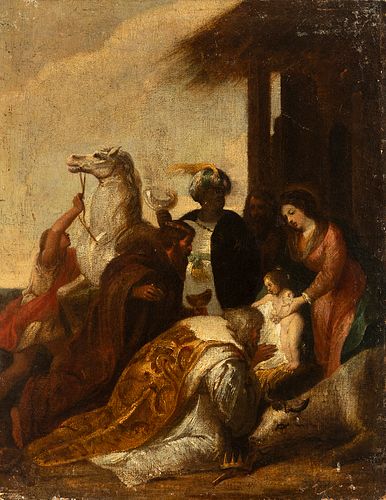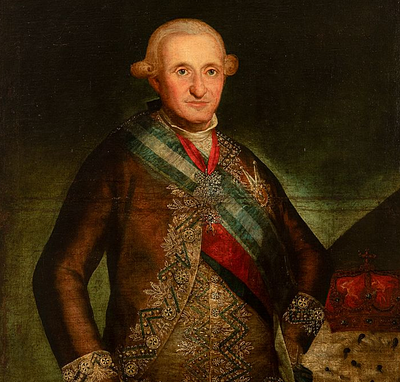Genoese school; 17th century. Circle of VALERIO CASTELO (Genoa, 1624-17 February 1659). "The Adoration of the Magi". Oil on canvas. Relined in the 19t
Lot 18
About Seller
Setdart Auction House
Carrer Aragó 346
Barcelona
Spain
Setdart Subastas was born in 2004 and is currently the first online art auction in Spain with solidity, prestige and reliability guaranteed by our more than 60,000 users. Setdart has a young, dynamic and enterprising team ready to successfully manage the purchase and sale of art works through custom...Read more
Estimate:
EUR€1,800 - EUR€2,000
$1,855.67 - $2,061.86
Absentee vs Live bid
Two ways to bid:
- Leave a max absentee bid and the platform will bid on your behalf up to your maximum bid during the live auction.
- Bid live during the auction and your bids will be submitted real-time to the auctioneer.
Bid Increments
| Price | Bid Increment |
|---|---|
| EUR€0 | EUR€10 |
| EUR€200 | EUR€25 |
| EUR€500 | EUR€50 |
| EUR€1,000 | EUR€100 |
| EUR€3,000 | EUR€200 |
| EUR€5,000 | EUR€500 |
| EUR€10,000 | EUR€1,000 |
| EUR€20,000 | EUR€2,000 |
| EUR€50,000 | EUR€5,000 |
About Auction
By Setdart Auction House
Sep 22, 2021
Set Reminder
2021-09-22 09:30:00
2021-09-22 09:30:00
America/New_York
Bidsquare
Bidsquare : 22nd September - ARAS JÁUREGUI Private Collection - Old Masters, 19th & 20th Century
https://www.bidsquare.com/auctions/setdart-auction-house/22nd-september---aras-j-uregui-private-collection---old-masters-19th-20th-century-7427
ARAS JÁUREGUI Private Collection - Old Masters, 19th & 20th Century Setdart Auction House sofia@setdart.com
ARAS JÁUREGUI Private Collection - Old Masters, 19th & 20th Century Setdart Auction House sofia@setdart.com
- Lot Description
Genoese school; 17th century. Circle of VALERIO CASTELO (Genoa, 1624-17 February 1659). "The Adoration of the Magi". Oil on canvas. Relined in the 19th century. It presents repainting and faults. Measurements: 38 x 49,5 cm. The present painting is represented in an exterior dominated by a golden sky, which surrounds the whole scene creating a warm atmosphere. In the left area of the composition, the upper area of the crib can be seen, like a ruined building, on which only the Virgin is sheltered, holding the Child, presenting him to the kings. This use of the manger makes it possible to combine interior and exterior in a reduced space. Despite the fact that, throughout the history of art, the scene depicting the adoration of the kings to the child has usually been populated by a multitude of figures, in this particular case, the artist reduced the scene to a minimum, even avoiding the presence of Saint Joseph. The use of a centripetal composition, in which all the figures seem to be crowded together, together with the lengthening of the canon and the somewhat artificial attitudes, are characteristics close to Valerio Castelo's work. Examples of this can also be found in the use of a golden atmosphere, already mentioned, which denotes the influence of Van Dyck. Valerio Castelo was an Italian Baroque painter born in Genoa. His father died when he was only six years old, so he was left in the care of the Torquato family. Due to his skill in drawing, the family encouraged his career as an artist by assigning him to the workshop of Domenico Fiasella. He subsequently studied with Giovanni Andrea de Ferrari. In search of new inspiration he travelled to Milan and then to Parma, probably between 1640 and 1645. In Milan he admired the work of Camillo Proccacini. From there he travelled to Parma. He excelled in painting battle scenes. In his works his admirers consider him to be a combination of the fire of Tintoretto with the general style of Paolo Veronese. Castello influenced the work of the young Domenico Piola. He also admired the work of Anthony van Dyck, who had spent much time in Genoa and whose paintings could be seen throughout the city. Among his pupils were Bartolomeo Biscaino, Giovanni Paolo Cervetto and Stefano Magnasco (Alessandro's father).
- Shipping Info
-
In-house shipping available. Please inquire at admin@setdart.com.
-
- Buyer's Premium



 EUR
EUR CAD
CAD AUD
AUD GBP
GBP MXN
MXN HKD
HKD CNY
CNY MYR
MYR SEK
SEK SGD
SGD CHF
CHF THB
THB
















